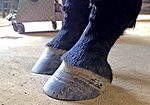Advertise Follow Us
Diseases
Tackling High-Low Syndrome From The High Side
Pennsylvania farrier finds focusing on getting upright hoof under control first helps bring the feet into closer symmetry
Read More
There's More Than One Kind of Heel Pain
Farriers face heel problems almost daily, but it’s important to understand that there are different causes, requiring different approaches
Read More
What About Joint Supplements?
Horse owners often ask about these, so here are some basics that hoof-care professionals should know
Read More








